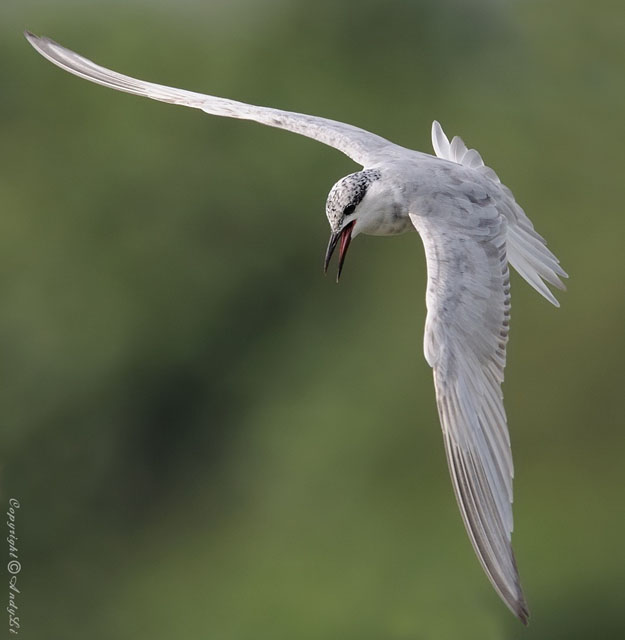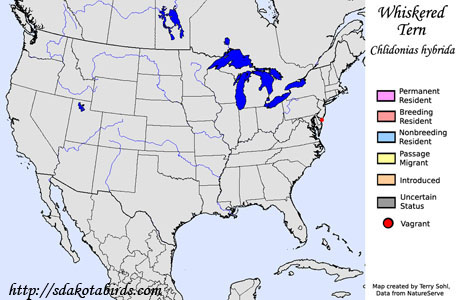| Length: 10 inches | Wingspan: 26 inches | Seasonality: Non-resident in South Dakota |
| ID Keys: Breeding plumage: Dark cap, white cheek, dark grey body. Non-breeding plumage: White underparts, much reduced black on cap. | ||
 The
Whiskered Tern is a bird of the Old World. They breed in scattered
locations in Europe, Asia, Africa, and Australia, and winter in much of
Africa, southern and southeast Asia, and the Australian region. The
species was unknown in North America until July of 1993, when a birdwatcher
spotted a Whiskered Tern feeding over a marshy wetland at Cape May, New
Jersey. Birders from across North America flocked to the New Jersey
shore for a chance to add the mega-rarity to their North American life
lists.
The
Whiskered Tern is a bird of the Old World. They breed in scattered
locations in Europe, Asia, Africa, and Australia, and winter in much of
Africa, southern and southeast Asia, and the Australian region. The
species was unknown in North America until July of 1993, when a birdwatcher
spotted a Whiskered Tern feeding over a marshy wetland at Cape May, New
Jersey. Birders from across North America flocked to the New Jersey
shore for a chance to add the mega-rarity to their North American life
lists.
Habitat: Found around freshwater marshes and wetlands during the summer breeding season. Non-breeding birds are found a variety of aquatic habitats, including saltwater marshes and coastlines. They will sometimes also feed over terrestrial habitats, including agricultural fields.
Diet: Feeds on insects, insect larvae, amphibians, small fish, and small invertebrates such as shrimp.
Behavior: Foraging for insects is most often done on the wing, dipping and swooping to capture insects in flight. They will also fly over the water's surface and dip down to grab food items at or near the water's surface. Gregarious in most seasons, much of their foraging is done in groups.
Nesting: A colonial nester, the nest of a Whiskered Tern is platform of vegetation, either resting on the bottom in very shallow water, or floating on the water's surface. The female usually lays 2 or 3 eggs. Both parents share incubation duties, and both help to raise the young.
Song: The most common call is a krrek.
Migration: Populations in more temperate zones are migratory. European birds largely winter in Africa, while many birds breeding in Asia winter in southern or southeastern Asia. Birds breeding in southern Australia typically move to northern Australia for the winter.
Interactive eBird map: Click here to access an interactive eBird map of Whiskered Tern sightings
Similar Species: Somewhat similar to the North American Black Tern in breeding plumage, while perhaps looking more like a Common Tern in non-breeding plumage.
Conservation Status: Populations are stable, they are found over a very wide geographic area, and they are common in parts of their range. The IUCN lists the Whiskered Tern as a species of "Least Concern".
Further Information: 1) British Trust for Ornithology - Whiskered Tern
2) BirdLife International - Whiskered Tern
3) Avibirds.com - Whiskered Tern
Photo Information: Photo taken by Andy Li - Photo licensed under Creative Commons Attribution NoDerivs 2.0 Generic License.
| Click below for a higher-resolution map |
 |
| South Dakota Status: Non-resident in South Dakota |
Additional Whiskered Tern Photos (coming soon!!)
